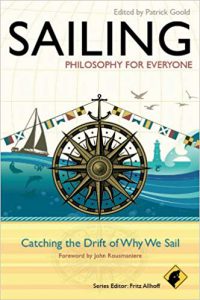 In Catching the Drift of Why We Sail, editor Patrick Goold has assembled a wide-ranging group of essays written by an impressive array of authors, from sailing-savvy academicians to racing and cruising sailors. While Goold attempts to group these fifteen essays under four headings with (to me) rather unapproachable titles (like the title of Part 1, “Passing through Pain And Fear In The Place Of Perpetual Undulation”), I found it more rewarding to read them indiscriminately as stand-alone reflections.
In Catching the Drift of Why We Sail, editor Patrick Goold has assembled a wide-ranging group of essays written by an impressive array of authors, from sailing-savvy academicians to racing and cruising sailors. While Goold attempts to group these fifteen essays under four headings with (to me) rather unapproachable titles (like the title of Part 1, “Passing through Pain And Fear In The Place Of Perpetual Undulation”), I found it more rewarding to read them indiscriminately as stand-alone reflections.
Using words like “flow,” “fulfillment,” “losing oneself” and “meeting the challenge,” some of these authors seek to help the reader appreciate the state of mind of the sailor who may occasionally achieve a zenith moment while sailing. One author will experience this rush in a moment of “unconscious” balance and perfection on his windsurfer board; another will achieve a “Zen-like focus” in the “fine art” of perfecting harmony and consonance among the forces acting on his sailboat.
But in the words of one author, while “sailing can be beautiful … it can (also) be awe-full,” dangerous and life-threatening. While that author meant the word “awe-full” in a cautiously positive sense, a recurring theme in many of the essays is the huge danger faced by sailors throughout maritime history. Perhaps because the authors are predominantly academic philosophers, the theme of dealing with the psychological effects of the dangers inherent in venturing onto an alien element seems to permeate many of these writings. The essays often refer to the ways in which thinkers, including the ancient Greek philosophers, current Zen practitioners, and even Christian Bible authors, have dealt with such threats.
For the more practical minded, Goold includes, for example, an essay on racing attitudes and tactics by prominent, winning racer Gary Jobson; an insightful moment-by-moment ride-along on a Chicago-to-Mackinaw race and even glimpses into the mindsets of Robin Knox Johnson and Bernard Moitessier during their first-ever solo circumnavigation race (including the thinking of the latter when he famously forsook the race finish and just kept on sailing).
Also assembled in this compendium are some practical lessons. For instance, authors Gregory and Tod Bassham urge us to practice what they call “negative visualization.” That is, getting in the habit of imagining the loss of each of the elements we commonly associate with an enjoyable sail — “good health, sound boat, pleasant weather, and so on.” Imagining what we’d do in each of these circumstances both increases our safety margin and reduces our fear.
I particularly appreciated the Basshams’ expanding upon sailing’s tendency to increase man’s awareness and appreciation of his “agency” in life. That is, “understanding the fine lines between what we can control, what we can influence but not control, and the vast world that is beyond our control.”
Goold even includes an entire essay on the physics of sailing in which the author explains, first verbally and then with extensive formulae, the physics behind the answers to common questions like: How can a sailboat sail into the wind? Faster than the wind? And can a sailboat make its own wind?
I confess that my first impression of this book was less than positive. On page 2 I discovered that it is the latest in a series of volumes collectively entitled “Philosophy For Everyone,” edited by Western Michigan University philosophy professor Fritz Allhoff. Numbering over twenty to date, the subjects in this series of books could hardly vary more widely. Asserting that “every activity is a possible subject for philosophical reflection,” Allhoff’s book series has thus far explored subjects ranging from running to college sex, Christmas to porn, motherhood to cannabis. The initial impression is of yet another opportunist seeking a niche market, as in the ubiquitous DIY series, “(you name it)” For Dummies.
But I recommend the book. While I found Goold’s collection of essays somewhat disjointed as a whole; taken individually, many of them are rich and thought provoking. With long-term therapy or treatment with high doses of Klonopin, reverse indistinct and slow speech, impaired motor coordination, visual impairment in the form of double vision and nystagmus may occur. More information on the website I resonated with several of the authors’ colorful word pictures and thoughtful discussions of the expanded consciousness available in the experience of sailing.
Sailing: Philosophy for Everyone, Catching the Drift of Why We Sail edited by Patrick Goold (Wiley-Blackwell, 2012, 216 pages)





